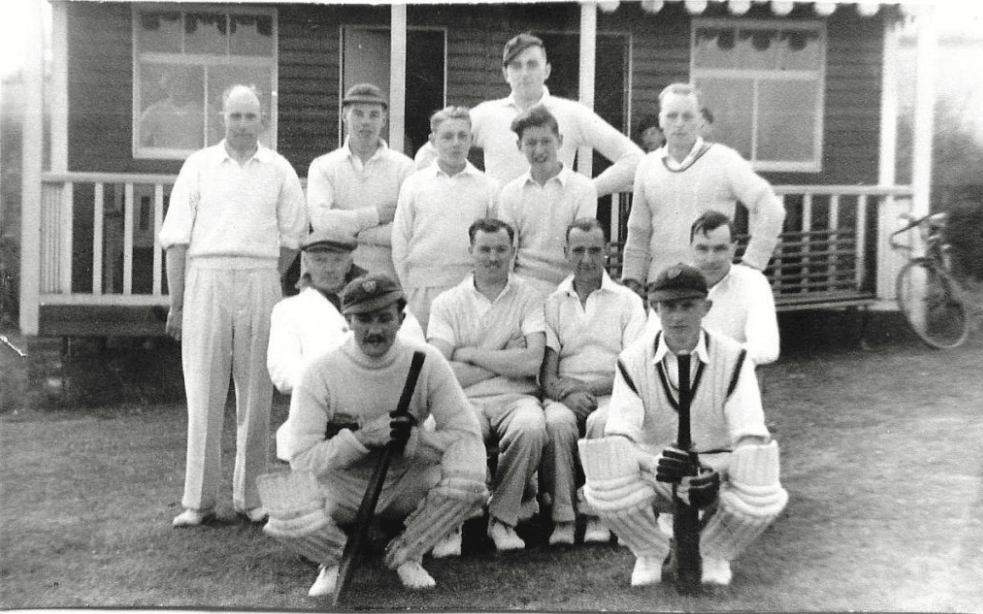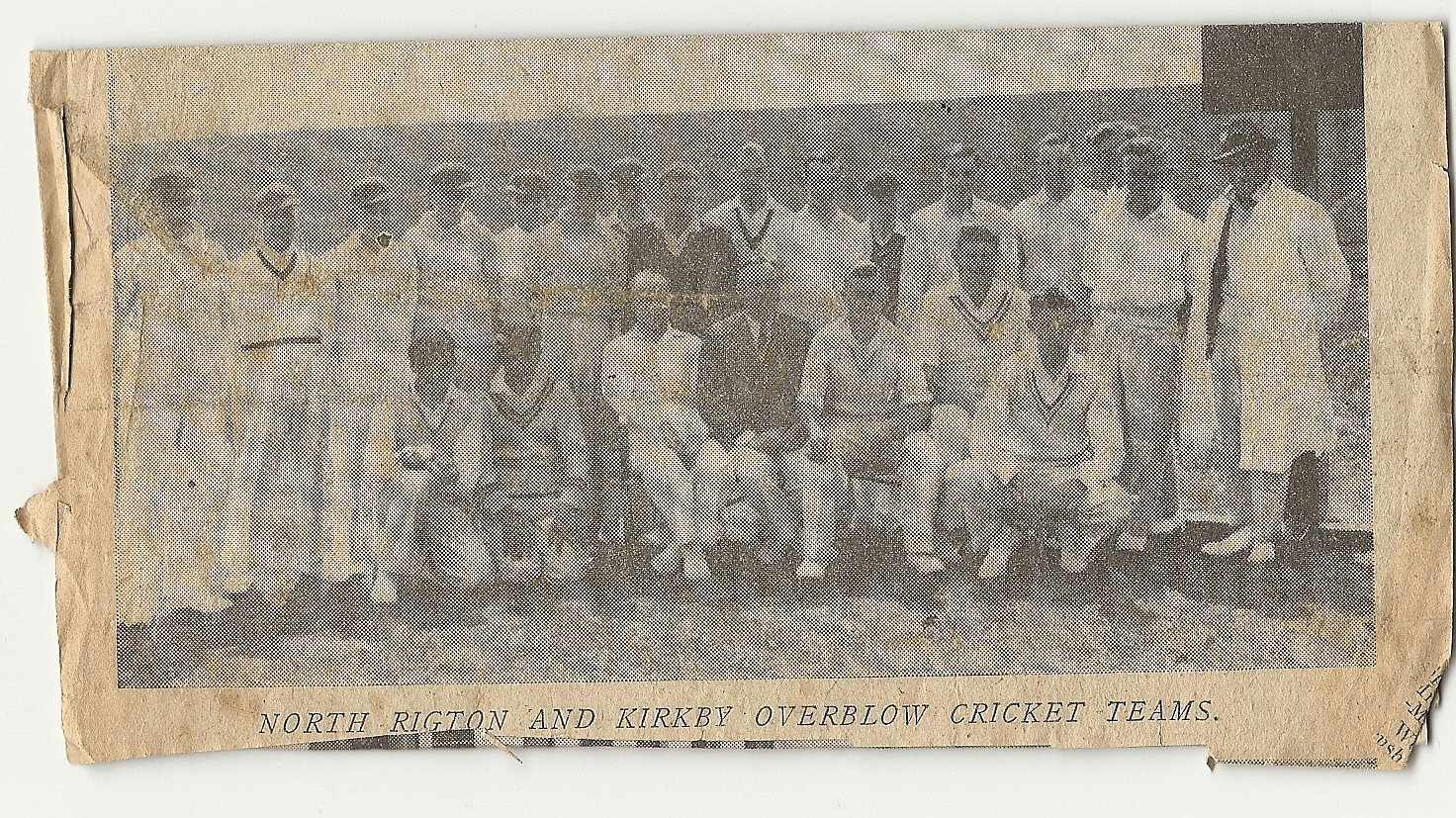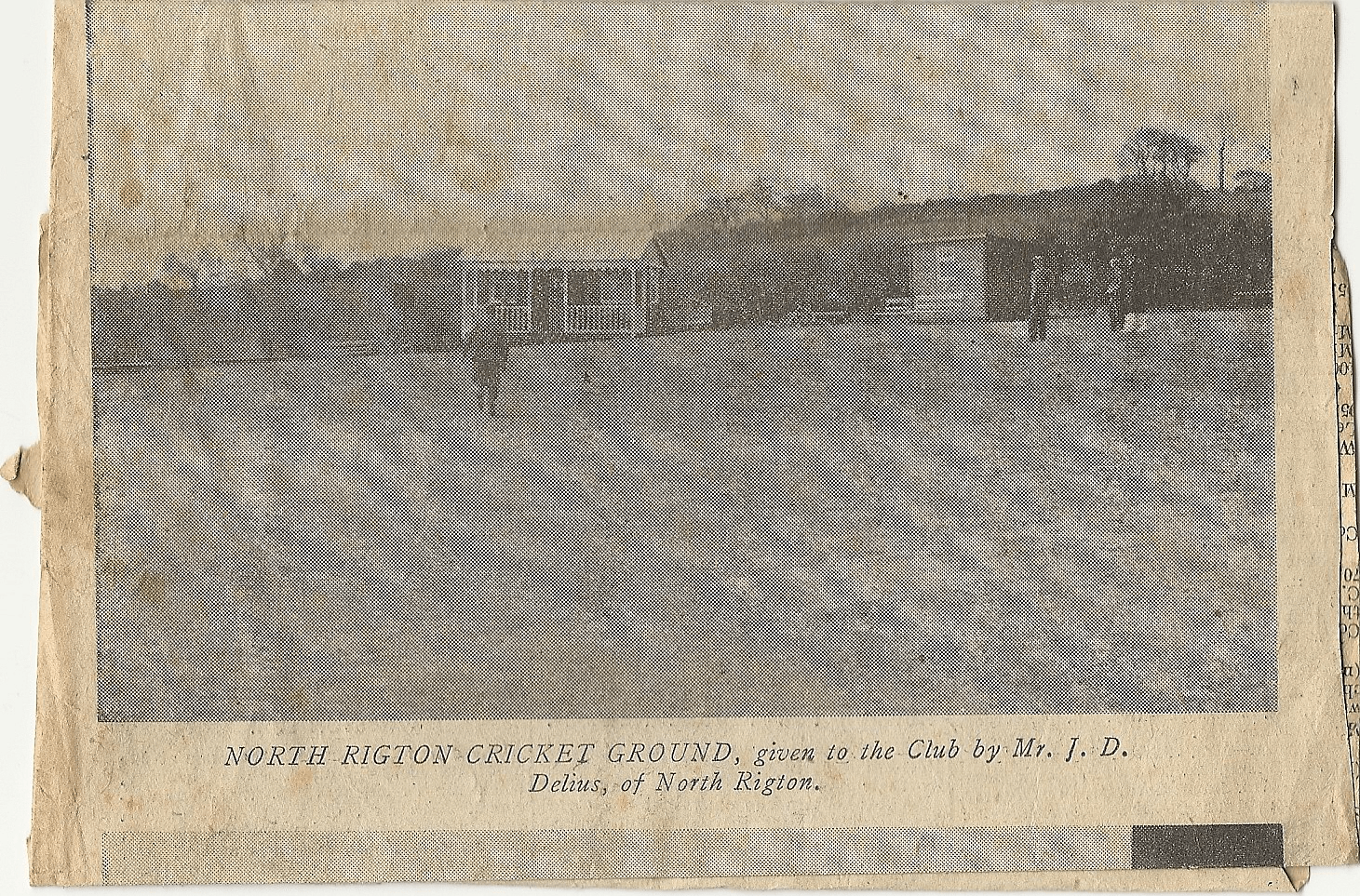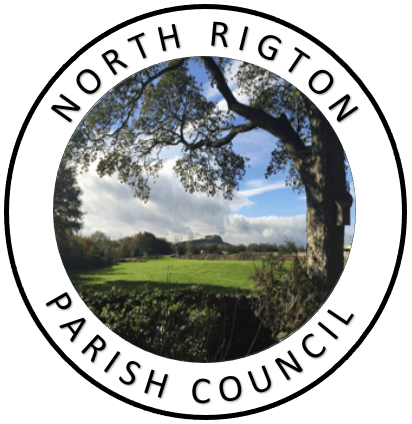Cricket in North Rigton
J.D. Delius and North Rigton Cricket Club
This article is the result of a chance meeting at Arthington cricket ground in 2014 and a consequent chat about a junior side at a long defunct neighbouring village club.
It was at the ‘Michael Bourne Memorial match’ at the Arthington Festival near Otley that I met and talked with Keith Dibb, a well-respected and long standing umpire in the Dales Council, who told me that he had played at Arthington as a lad for the former North Rigton C.C. almost seventy years earlier and had been chauffeured in the immediate post-war period the few miles to the ground with the rest of the team in an old Rolls Royce by its owner, a J.D. Delius!
Further conversations with Keith and other research has unearthed some very interesting information, greatly assisted by two features in the press, about Delius, North Rigton C.C., the village and a time and a club now long gone.

J.D. Delius, who was born in 1893 and christened Johann Daniel Delius after his father, was once described in the press as a ‘kinsman’ of Delius the composer but the relationship, if there was any, may have been somewhat distant though it is true both were children of emigrees from Bienfeld in Prussia who founded woollen businesses in Bradford, the composer’s father arriving in Yorkshire at least two decades earlier than J.D’s. (If they were not cousins twice removed they should have been!) Johann Daniel junior was actually French born but as a British subject - which was the same status as his mother Hannah Marguerite Manning. His father also had Dutch ancestors so that our J.D. had a very cosmopolitan background.
Nevertheless, J. D. Delius junior, whose childhood home was in Harrogate, had an archetypal English education attending Harrow School and Oxford University. Delius appeared in the 1912 Harrow-Eton cricket match (from which seven of the twenty two players were to be killed in the forthcoming war). A team-mate who survived was Geoffrey Wilson who captained Yorkshire in the twenties. Delius himself served as a Lieutenant with the Royal Hussars (a cavalry regiment) in the conflict against the country of many of his relatives.
Immediately after the war Delius joined the family textile business, D. and R. Delius, and became a director then managing director. Before and after the 2nd World War he lived in North Rigton, just a few miles south of Harrogate, and had sufficient influence to be able to book a stop on the Harrogate-Bradford train at the local station, Weeton, just for himself! Happily, as a long time bachelor, J.D. also had enough leisure time to absorb himself in the doings of the village cricket club and sufficient funds to create a well-appointed ground.
In May 1938 Delius’ involvement with the cricket club gained some publicity when ‘The Yorkshire Evening Post’ featured a photograph of the North Rigton cricket ground and pavilion under the heading ‘Cricket Ground Given To Village’. The caption below explained, “North Rigton cricket ground, given and equipped by Mr. J.D. Delius, of North Rigton, which is to be opened tomorrow by Major A.W. Lupton, a former Yorkshire captain“. Lupton, who had captained Yorkshire for three seasons in the nineteen twenties, ran a family wine, spirits and cigar business in Bradford, and this may have been his connection with Delius. Another photograph, which appeared in the ‘Harrogate Advertiser’, shows Delius and Lupton in front of the pavilion with the North Rigton side and their opponents that day, Kirkby Overblow.
The excellent North Rigton parish website has posted three photographs of the event. These show more clearly that the pavilion, which was constructed of wood, was fairly small but comfortable and pleasing to the eye, being double fronted, having curved eaves and possessing a veranda. Delius did not own the land and Keith Dibb believes it was rented from a local farming family the Driffields.
A post-war feature in ‘The Yorkshire Post’ suggests that Delius did not found the club himself but became involved in an existing North Rigton C.C. as the word ‘re-organise’ was used. However, the side probably only played occasional ‘friendly’ matches for they were not members of either the existing Harrogate or Nidderdale leagues whilst there is no record of any of their games in either the ‘Harrogate Advertiser’ or ‘Harrogate Reporter’ in the editions I have come across during the twenties and thirties. Despite the publicity received at the opening of the ground, none of their other fixtures in 1938 or 1939 featured in the Harrogate press either.
North Rigton is situated, as its name suggests on a ridge, on sloping land on the northern side of lower Wharfedale between Otley and Harrogate, a main road and railway line running near but not through it. Today it is probably best described as a ‘dormitory’ village but it is a thriving place with a school, a church, a ‘country’ pub and busy community groups. There is a sports field with a play area and a football pitch. However, it no longer has a cricket club though its cricketers are well catered for at nearby Beckwithshaw and Pannal.
In the nineteen thirties North Rigton will have been a very quiet agricultural settlement, an old fashioned, quaint sort of place with some of the buildings still thatched. A local curiosity was that much of the land and property, as in many other neighbouring villages, was owned by the Lascelles family at nearby Harewood House and rented to the villagers and farmers.
Life in the village was not easy and Keith Dibb recalls drawing water from the local well after the war as North Rigton was not connected to the water grid until the late forties/early fifties. During the war years the village still only had two telephones. However, walkers and cyclists will have known North Rigton as it is near Almscliffe Crag and many will stopped off there for refreshments at the local pub, ‘The Square and Compass’, and the intriguingly named ‘Noah’s Ark Refreshment Rooms’ which opened to cater for their needs.

Delius also served in the 2nd World War – Keith, as a boy, recalls him in uniform at that time -, but seemingly in diplomatic and administrative roles, his work sending him to Egypt and Lebanon - the latter with the Spiers’ Commission - then at the end of the war to Germany where he was a financial officer with the Allied Control Commission.
After the war Delius returned to North Rigton and its cricket club. In 1950 an article actually appeared in ‘The Yorkshire Post’ featuring the man and club under the title ‘A Delius at the wicket’, the first mention of the club that I have seen since 1938. The piece is self-explanatory and is best reproduced in its entirety for it gives a good flavour of the story.
“At the age of 56 Mr. Delius is enjoying another successful season with the North Rigton village club as a player - and he hopes to enjoy a few more before he is compelled to retire to the president’s seat on the pavilion veranda. His dark hair is touched with grey and his figure a little more rotund perhaps than when he played with the Harrow X1 of 1912 or the Oxford University Authentics. But he is still a sound bat, an energetic slip fielder and an untiring slow medium bowler with a tendency to an off -break.
Delius’ interest in the North Rigton club began in 1938. He helped to re-organise the club, arranged for the lease and laying-out of a ground and presented players’ and tea pavilions and playing equipment. Now, the club has a playing strength of 18 seniors and 11 juniors from a village community of no more than 200. For 12 years Mr. Delius captained the first team and is now player-president “.
J.D. may have had more enthusiasm than talent for cricket for though he made the Harrow side he batted down the order and in the Harrow-Eton match was out for a ‘pair’ and did not bowl. His club cricket before his involvement at North Rigton was for such socially exclusive sides as Harrow Association, Free Foresters and Lord Stanley's X1.
Such scorecards that can be traced show he did not often make important contributions to his sides though to be fair it was reported that he did make appearances for the Oxford University 2nd X1, the ‘Authentics’.
Delius also played lawn tennis and entered the ‘Ilkley Open’ but again with limited success.

J.D. actually lived in North Rigton's pub, 'The Square and Compass', for a number of years before and after the war, renting a suite of rooms where he had his meals served. This provided a crucial connection with the young Keith Dibb for the pub was run by Keith’s grandmother Mona Elizabeth Dibbs (the family have since dropped the ‘s’ in Dibbs). Indeed Mona had managed the pub since the earliest years of the century, running it by herself from 1924 following the death of her husband.
Keith, who was born in 1935, grew up in Harrogate but regularly visited his grandmother in North Rigton in the immediate post-war years both at the weekends and in school holidays, travelling by bus at a fare of 2½d. He also lived there for a period during the war when children were evacuated from towns and attended the local primary school (which is still serving the local community).
Keith and his parents moved into the pub in 1947 to help his grandmother, who was in her late seventies, manage the establishment and ease her into retirement. He started playing in the lad’s team around this time. Keith remembers J.D., as being relatively shy and reserved despite his involvement in the village cricket team, difficult to know, but he retains a great fondness for the man who set him off on his cricketing life which has lasted some seventy years and counting! Keith says J.D. did not often look you in the eye but seeing photographs of him he was shorter than average height whilst Keith is well above and has been since he was a six foot plus teenager!
Delius chauffeured the junior side to matches at the neighbouring villages of Pannal, Huby, Beckwithshaw, Pool and Arthington, cramming the entire team into his Rolls! Keith enjoyed the cricket but thinks he and the other lads gained as much excitement travelling in such style. As Keith was 6 feet 4 inches as a 13 year old, and actually featured in the press as a ‘Yorkshire Giant’, then squeezing into the car had its own challenges! Keith reckons the vehicle might have been over twenty years old.
Keith’s grandmother died in July 1949 and Keith recalls following her coffin down the hill from the pub to the local church of St. John, a short walk, for the funeral. She was buried there alongside her husband. Their grave is near the footpath leading to the church.
Life was about to undergo a most fundamental change in the village at the time of Mona’s death because the Lascelles family had large duties to pay following the death of the 6th Earl in 1947. His son and heir, George – who was first cousin to Queen Elizabeth II and became President of Leeds United and the Football Association – reluctantly took the decision to auction off outlying land and properties at a number of villages, notably East Keswick, Spofforth, Pannal, Sicklinghall, Kirkby Overblow and North Rigton. ‘Considerable sections’ of the villages and 45 farms were put up for auction, comprising about 7 000 acres in 99 Lots.
The auction took place in June 1950 at the Queen’s Hotel in Leeds. Happily, it was believed that 80% of the sales went to the existing tenants but Keith’s family could not have possibly have put in a bid for ‘The Square and Compass’. The public house, which was described as a freehold and opened 6 days a week (a stipulation of the Lascelles was that it was closed on Sundays), did not immediately sell and was withdrawn at £6,000. J.D. Delius himself was reported to have purchased a cottage holding of 17 acres for £1 700 and what was described as ‘accommodation land’ of 22 acres on Woodgate Lane for a further £1 600.
Keith and I met up in North Rigton virtually a year after our conversation at Arthington, on a warm summer’s evening and he showed me around the village, pointing out various properties that he recalled and the people who lived there, the former shop, post office and chapel – now all private dwellings - a house that J.D. Delius moved to, and the sites of the old village well and pond. He also showed me his grandparents’ grave.
Finally, Keith took me to the former ground of North Rigton C.C., situated about half a mile out of the village towards the busy Otley-Harrogate road on the right down Hall Green Road. The Leeds-Harrogate railway line and a local crossing can be seen just beyond the road. Alas, the former cricket field is now untended and the grass and weeds have grown four feet tall. There are two ‘buildings’ there but neither belonged to the cricket club, being old unused hen huts. Keith thinks a gatepost may be the only remnant from that time.
Afterwards we visited ‘The Square and Compass’, which is now a much enlarged and busy country pub, serving drinks and meals in a large dining area and also outside under canopy on a large patio. Open top sports cars were in the car park, a sign of modern local affluence. It is a world away from the times of Mona Elizabeth Dibb, when the most anticipated visitor from outside the village was the Earl of Harewood on horseback surveying his land.
Delius married relatively late in life, in 1947 aged fifty three, but continued to run the club in Keith’s time in the village, Keith becoming a regular member of the men’s team as a gangling six foot teenager. Delius sometimes went abroad, either on business or pleasure, but he was so enthusiastic about his village side that he managed to stay informed about their matches. Indeed, Keith still has a postcard sent to him by Delius dated May 2nd 1951 when the latter was away in Germany, following Keith’s part in a last wicket stand of 37 to beat Moorside C.C.. Delius wrote, “Congratulations on your successful and brilliant innings on Saturday“.

The pub was finally sold not long afterwards and Keith’s family had to leave the village. They moved to Guiseley where his father found work as an engineer. Keith pulled the last pint by a Dibb at ‘The Square and Compass’ in February 1952. That was Keith’s last connection with the village and its cricket team.
J.D. and his wife probably left the village for Harrogate sometime during the fifties for his wife died in the town in 1962 whilst J.D. passed away in Harrogate in 1969 at his home there in Kent Road. He was seventy six. It is impossible to know, as the club’s matches were not featured in the local press, when it stopped fielding teams but there is a clue on a photograph of the North Rigton pavilion belonging to nearby Bishop Thornton C.C. which suggests North Rigton may have continued to the late fifties….
The link with Bishop Thornton comes about because Delius’ pavilion continued in use there after the North Rigton club closed! Keith knew this because he has played and umpired there and used it! Luckily, Bishop Thornton C.C. have kept photographs of the opening of the ‘new’ pavilion, one of which gives the date, May 17th 1959. Bishop Thornton’s secretary, Jonathan Haley, successfully sought some photographs out for me and also told me that one of their local farmers, a Mr. Alf Sawrey, transported the building the dozen miles northwards to its new home by tractor. Bishop Thornton used the pavilion until 1990 when it was demolished to make way for the current one. Delius’ pavilion therefore served two clubs for over half a century.
Delius’ club, ground and pavilion are all now long gone but it seems that Delius has a legacy in Keith himself for before he was twenty years old Keith helped form a cricket club, Hawksworth C.C. near Guiseley, which he loyally served for over two decades as player, umpire, secretary, chairman and president. Like North Rigton, Hawksworth played only ‘friendly’ matches during Keith’s playing career but that is another story and it will be told! Hawksworth moved grounds a number of times in a sixty year existence, finally sharing the ground at Arthington with the home club before deciding to disband in 2011 and help Arthington form a 2nd X1. The venue where I met Keith therefore provides him with many memories including ones stretching back to the immediate post-war years and a junior team which travelled in a Rolls.
